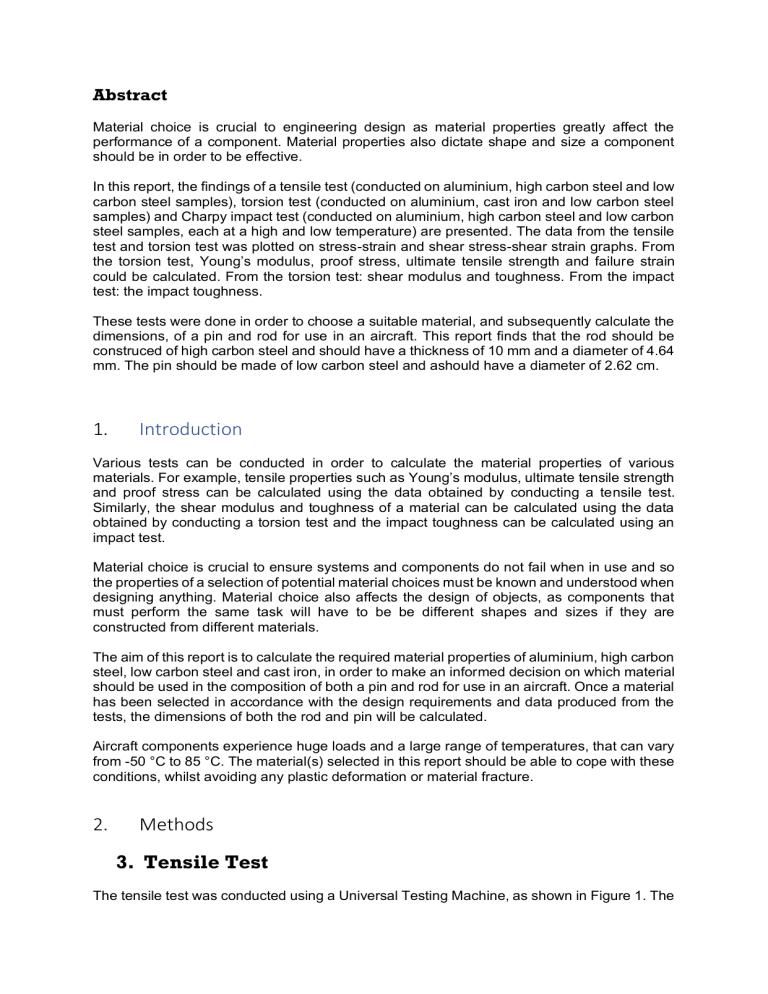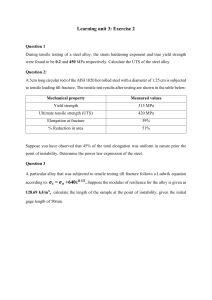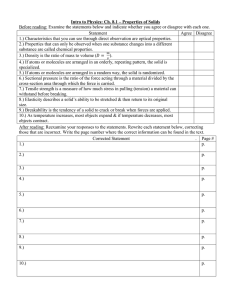
Abstract Material choice is crucial to engineering design as material properties greatly affect the performance of a component. Material properties also dictate shape and size a component should be in order to be effective. In this report, the findings of a tensile test (conducted on aluminium, high carbon steel and low carbon steel samples), torsion test (conducted on aluminium, cast iron and low carbon steel samples) and Charpy impact test (conducted on aluminium, high carbon steel and low carbon steel samples, each at a high and low temperature) are presented. The data from the tensile test and torsion test was plotted on stress-strain and shear stress-shear strain graphs. From the torsion test, Young’s modulus, proof stress, ultimate tensile strength and failure strain could be calculated. From the torsion test: shear modulus and toughness. From the impact test: the impact toughness. These tests were done in order to choose a suitable material, and subsequently calculate the dimensions, of a pin and rod for use in an aircraft. This report finds that the rod should be construced of high carbon steel and should have a thickness of 10 mm and a diameter of 4.64 mm. The pin should be made of low carbon steel and ashould have a diameter of 2.62 cm. 1. Introduction Various tests can be conducted in order to calculate the material properties of various materials. For example, tensile properties such as Young’s modulus, ultimate tensile strength and proof stress can be calculated using the data obtained by conducting a tensile test. Similarly, the shear modulus and toughness of a material can be calculated using the data obtained by conducting a torsion test and the impact toughness can be calculated using an impact test. Material choice is crucial to ensure systems and components do not fail when in use and so the properties of a selection of potential material choices must be known and understood when designing anything. Material choice also affects the design of objects, as components that must perform the same task will have to be be different shapes and sizes if they are constructed from different materials. The aim of this report is to calculate the required material properties of aluminium, high carbon steel, low carbon steel and cast iron, in order to make an informed decision on which material should be used in the composition of both a pin and rod for use in an aircraft. Once a material has been selected in accordance with the design requirements and data produced from the tests, the dimensions of both the rod and pin will be calculated. Aircraft components experience huge loads and a large range of temperatures, that can vary from -50 °C to 85 °C. The material(s) selected in this report should be able to cope with these conditions, whilst avoiding any plastic deformation or material fracture. 2. Methods 3. Tensile Test The tensile test was conducted using a Universal Testing Machine, as shown in Figure 1. The sample was loaded into the machine and then preloaded with a 5kN tensile force, using the control panel, in order to remove the slack from the experimental set up, before the displacement value was set to zero. The three samples were: aluminium, high carbon steel and low carbon steel. Before the samples were loaded into the machine, their gauge length was recorded using vernier callipers and their diameter was measured at 3 points along their gauge lengths using a micrometer. The diameter measurements for each sample samples were then averaged out. Once a sample was inserted into the grips of the machine, the extensometer was attached (as shown in Figure 2) in order to accurately measure small strain extensions in the sample during elastic deformation. However, once the material began to yield, the extensometer had to be removed so as not to damage it. The UTM was connected to a computer that recorded the time, force, displacement, tensile stress and tensile strain data of the experiment as a .csv file. The .csv files for the tensile test of each experiment were then used in a python script in order to calculate the Young’s Modulus, proof stress, ultimate tensile strength and failure strain of each material. This was done by plotting a stress-strain curve and identigying various key points on the curve that corresponded to ultimate tensile strength and failure strain. Young’s modulus was calculated by finding the gradient of the elastic region and proof stress was found by drawing a line parallel to the elastic region, offset by a strain of 0.2%.


